[1] ALLEN AR. Surgery of experimental lesion of spinal cord equivalent to crush injury of fracture dislocation of spinal column. J Am Med Assoc. 1911;57:878-890.
[2] CHIANG J, KOWADA M, AMES A, et al. Cerebral ischemia. III. Vascular changes. Am J Pathol. 1968;52(2):455-476.
[3] MCCORD JM. Oxygen- derived free radicals in postischemic tissue injury. N Engl J Med. 1985;312(3):159-163.
[4] JING N, FANG B, LI Z, et al. Exogenous activation of cannabinoid-2 receptor modulates TLR4/MMP9 expression in a spinal cord ischemia reperfusion rat model. J Neuroinflammation. 2020;17(1):101.
[5] AL MAMUN A, WU Y, MONALISA I, et al. Role of pyroptosis in spinal cord injury and its therapeutic implications. J Adv Res. 2021;28:97-109.
[6] MI J, YANG Y, YAO H, et al. Inhibition of heat shock protein family A member 8 attenuates spinal cord ischemia-reperfusion injury via astrocyte NF-κB/NLRP3 inflammasome pathway: HSPA8 inhibition protects spinal ischemia-reperfusion injury. J Neuroinflammation. 2021;18(1):170.
[7] GU C, LI L, HUANG Y, et al. Salidroside Ameliorates Mitochondria-Dependent Neuronal Apoptosis after Spinal Cord Ischemia-Reperfusion Injury Partially through Inhibiting Oxidative Stress and Promoting Mitophagy. Oxid Med Cell Longev. 2020;2020:3549704.
[8] 陈梦吉,叶佳辉,应一博,等.氧调控性神经生长因子基因修饰神经干细胞移植治疗急性脊髓损伤[J].中华骨科杂志,2020,40(10):669-679.
[9] ANWAR MA, AL SHEHABI TS, EID AH. Inflammogenesis of Secondary Spinal Cord Injury. Front Cell Neurosci. 2016;10:98.
[10] WU J, SUN L, LI H, et al. Roles of programmed death protein 1/programmed death-ligand 1 in secondary brain injury after intracerebral hemorrhage in rats: selective modulation of microglia polarization to anti-inflammatory phenotype. J Neuroinflammation. 2017;14(1):36.
[11] TANG Y, LE W. Differential Roles of M1 and M2 Microglia in Neurodegenerative Diseases. Mol Neurobiol. 2016;53(2):1181-1194.
[12] GOGOLEVA VS, DRUTSKAYA MS, ATRETKHANY KS. The Role of Microglia in the Homeostasis of the Central Nervous System and Neuroinflammation. Mol Biol (Mosk). 2019;53(5):790-798.
[13] LIU Z, YAO X, JIANG W, et al. Advanced oxidation protein products induce microglia-mediated neuroinflammation via MAPKs-NF-κB signaling pathway and pyroptosis after secondary spinal cord injury. J Neuroinflammation. 2020; 17(1):90.
[14] TA NA HS, AN M, ZHANG T, et al. Dexmedetomidine inhibits microglial activation through SNHG14/HMGB1 pathway in spinal cord ischemia-reperfusion injury mice. Int J Neurosci. 2020;1:1-12.
[15] CHIU C W, HUANG W H, LIN SJ, et al. The immunomodulator decoy receptor 3 improves locomotor functional recovery after spinal cord injury. J Neuroinflammation. 2016;13(1):154.
[16] FU H, ZHAO Y, HU D, et al. Depletion of microglia exacerbates injury and impairs function recovery after spinal cord injury in mice. Cell Death Dis. 2020;11(7):528.
[17] BELLVER-LANDETE V, BRETHEAU F, MAILHOT B, et al. Microglia are an essential component of the neuroprotective scar that forms after spinal cord injury. Nat Commun. 2019;10(1):518.
[18] CHISTIAKOV DA, MYASOEDOVA VA, REVIN VV, et al. The impact of interferon-regulatory factors to macrophage differentiation and polarization into M1 and M2. Immunobiology. 2018;223(1):101-111.
[19] SHAPOURI-MOGHADDAM A, MOHAMMADIAN S, VAZINI H, et al. Macrophage plasticity, polarization, and function in health and disease. J Cell Physiol. 2018; 9(233):6425-6440.
[20] ARORA S, DEV K, AGARWAL B, et al. Macrophages: their role, activation and polarization in pulmonary diseases. Immunobiology. 2018;223(4-5):383-396.
[21] ATRI C, GUERFALI FZ, LAOUINI D. Role of human macrophage polarization in inflammation during infectious diseases. Int J Mol Sci, 2018,19(6):E1801.
[22] LI H, WANG P, TANG L, et al. Distinct Polarization Dynamics of Microglia and Infiltrating Macrophages: A Novel Mechanism of Spinal Cord Ischemia/Reperfusion Injury. J Inflamm Res. 2021;14:5227-5239.
[23] ZHOU X, WAHANE S, FRIEDL MS, et al. Microglia and macrophages promote corralling, wound compaction and recovery after spinal cord injury via Plexin-B2.Nat Neurosci. 2020;23(3):337-350.
[24] LINNERBAUER M, WHEELER MA, QUINTANA FJ. Astrocyte Crosstalk in CNS Inflammation. Neuron. 2020;108(4):608-622.
[25] JHA MK, LEE WH, SUK K. Functional polarization of neuroglia: Implications in neuroinflammation and neurological disorders. Biochem Pharmacol. 2016;103:1-16.
[26] IIZUMI T, TAKAHASHI S, MASHIMA K, et al. A possible role of microglia-derived nitric oxide by lipopolysaccharide in activation of astroglial pentose-phosphate pathway via the Keap1/Nrf2 system. J Neuroinflammation. 2016;13(1):99.
[27] WANG G, WENG YC, CHIANG IC, et al. Neutralization of Lipocalin-2 Diminishes Stroke-Reperfusion Injury. Int J Mol Sci. 2020;21(17):E6235.
[28] SUN L, LI M, MA X, et al. Inhibition of HMGB1 reduces rat spinal cord astrocytic swelling and AQP4 expression after oxygen-glucose deprivation and reoxygenation via TLR4 and NF-κB signaling in an IL-6-dependent manner. J Neuroinflammation. 2017;14(1):231.
[29] LI Y N, GAO Z W, LI R, et al. Aquaporin 4 regulation by ginsenoside Rb1 intervenes with oxygen-glucose deprivation/reoxygenation-induced astrocyte injury. Medicine (Baltimore). 2019;98(42):e17591.
[30] WANG C, XU Y, HUANG Y, et al. Effects of erythropoietin and methylprednisolone on AQP4 expression in astrocytes. Mol Med Rep. 2017;16(5):5924-5930.
[31] VIDAL PM, ULNDREAJ A, BADNER A, et al. Methylprednisolone treatment enhances early recovery following surgical decompression for degenerative cervical myelopathy without compromise to the systemic immune system. J Neuroinflammation. 2018;15(1):222.
[32] SIMON FH, ERHART P, VCELAR B, et al. Erythropoietin preconditioning improves clinical and histologic outcome in an acute spinal cord ischemia and reperfusion rabbit model. J Vasc Surg. 2016;64(6):1797-1804.
[33] ERYILMAZ F, FAROOQUE U. The Efficacy of Combined Medication With Methylprednisolone and Erythropoietin in the Treatment of Ischemia-Reperfusion Injury to the Spinal Cord in Patients With Cervical Spondylotic Myelopathy. Cureus. 2021;13(3):e14018.
[34] GüRER B, KARAKOC A, BEKTAşOğLU PK, et al. Comparative effects of vitamin D and methylprednisolone against ischemia/reperfusion injury of rabbit spinal cords. Eur J Pharmacol. 2017;813:50-60.
[35] JHA MK, JO M, KIM JH, et al. Microglia-Astrocyte Crosstalk: An Intimate Molecular Conversation. Neuroscientist. 2019;25(3):227-240.
[36] IIZUMI T, TAKAHASHI S, MASHIMA K, et al. A possible role of microglia-derived nitric oxide by lipopolysaccharide in activation of stroglial pentose-phosphate pathway via the Keap1/Nrf2 system. J Neuroinflammation. 2016;13(1):99.
[37] LIDDELOW SA, GUTTENPLAN KA, CLARKE LE, et al. Neurotoxic reactive astrocytes are induced by activated microglia. Nature. 2017;541(7638):481-487.
[38] TRIPATHI P, RODRIGUEZ-MUELA N, KLIM JR, et al. Reactive Astrocytes Promote ALS-like Degeneration and Intracellular Protein Aggregation in Human Motor Neurons by Disrupting Autophagy through TGF-beta1. Stem Cell Reports. 2017; 9(2):667-680.
[39] ANDERSON MA, BURDA JE, REN Y, et al. Astrocyte scar formation aids central nervous system axon regeneration. Nature. 2016;532(7598):195-200.
[40] SHINOZAKI Y, SHIBATA K, YOSHIDA K, et al. Transformation of Astrocytes to a Neuroprotective Phenotype by Microglia via P2Y(1) Receptor Downregulation. Cell Rep. 2017;19(6):1151-1164.
[41] YU Q, TIAN DL, TIAN Y, et al. Elevation of the Chemokine Pair CXCL10/CXCR3 Initiates Sequential Glial Activation and Crosstalk During the Development of Bimodal Inflammatory Pain after Spinal Cord Ischemia Reperfusion. Cell Physiol Biochem. 2018;49(6):2214-2228.
[42] JIN H, GE X, HUAN Z, et al. Stress-induced phosphoprotein 1 restrains spinal cord ischaemia-reperfusion injury by modulating NF-kappaB signalling. J Cell Mol Med. 2021;25(24):11075-11084.
|
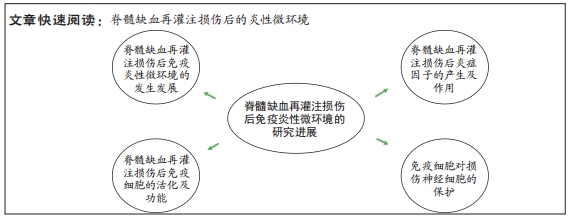
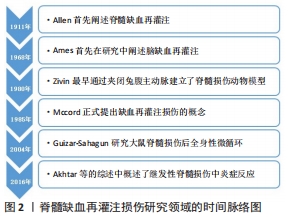
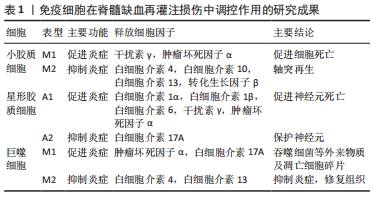
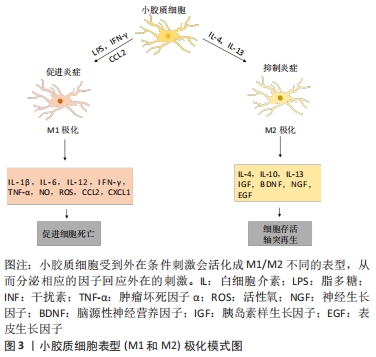
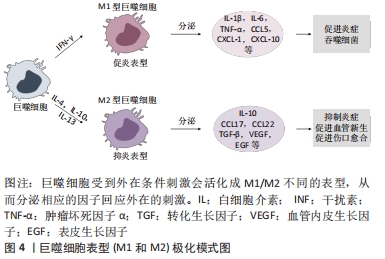
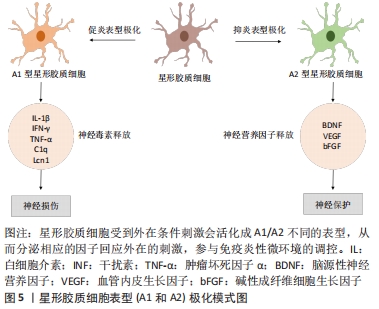

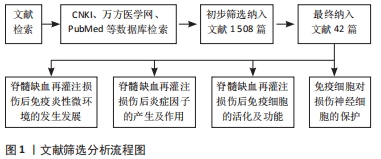
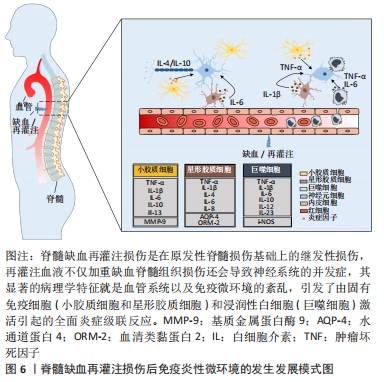 3.2 既往他人在该领域研究的贡献和存在的问题 既往对于脊髓缺血再灌注损伤中免疫炎性微环境研究主要分为临床和基础两部分,临床研究主要聚焦于寻找脊髓缺血再灌注损伤治疗靶点以及药物,基础研究主要聚焦于脊髓缺血再灌注损伤发生发展的潜在分子机制。脊髓缺血再灌注损伤的发生发展较为复杂,由多种免疫细胞参与并影响多个相关的组织器官,因此既往研究分散,尚没有学者进行系统性的研究。
3.2 既往他人在该领域研究的贡献和存在的问题 既往对于脊髓缺血再灌注损伤中免疫炎性微环境研究主要分为临床和基础两部分,临床研究主要聚焦于寻找脊髓缺血再灌注损伤治疗靶点以及药物,基础研究主要聚焦于脊髓缺血再灌注损伤发生发展的潜在分子机制。脊髓缺血再灌注损伤的发生发展较为复杂,由多种免疫细胞参与并影响多个相关的组织器官,因此既往研究分散,尚没有学者进行系统性的研究。